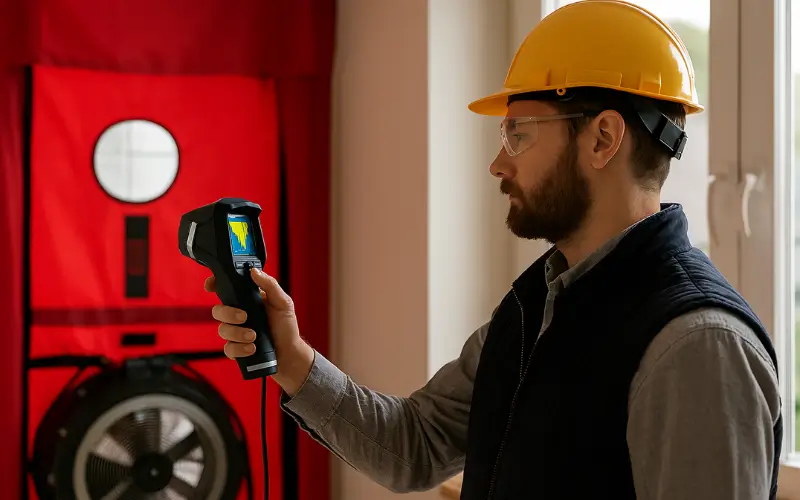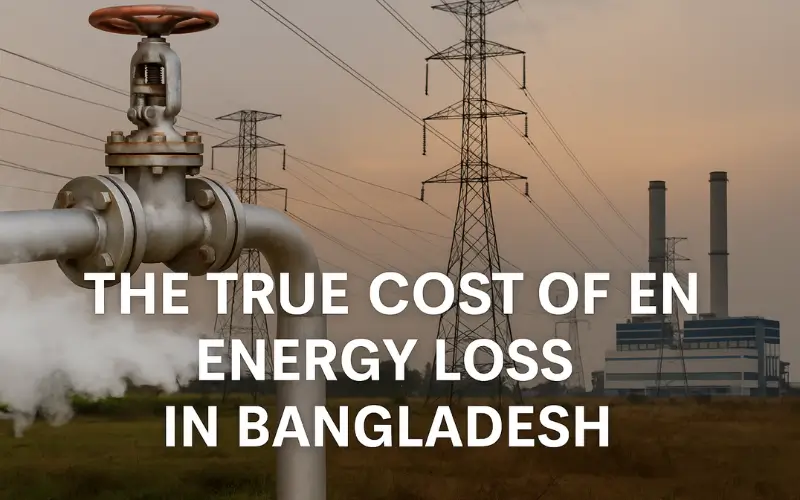If your utility bills are creeping up or your home never seems quite comfortable, it might be time to look deeper—literally. A professional energy audit does exactly that. It’s a thorough, technical examination of your home’s energy use to identify where energy is being lost and how you can save more of it.
But what actually happens during an energy audit?
Whether you’re considering one for the first time or you’re just curious about how it works, this guide will walk you through what to expect—from preparation to testing to the final recommendations. We’ll cover every step in the process and show you how it can lead to lower energy bills, better comfort, and a smaller carbon footprint.
Let’s dive into how this process works—and why it’s a smart move for your home or business.
What Is an Energy Audit?
An energy audit is a systematic assessment of how energy is used in your home, building, or facility. The goal is simple: identify where energy is being wasted and find cost-effective solutions to reduce that waste.
In Simple Terms:
It’s like a health checkup for your home’s energy system. Instead of checking your blood pressure and heartbeat, the auditor checks your insulation, HVAC systems, lighting, windows, appliances, and more—all to diagnose inefficiencies and prescribe improvements.
Types of Energy Audits
There are different levels of energy audits, depending on the detail and depth of analysis:
Level 1: Walkthrough Audit
- Basic visual inspection
- Identifies obvious energy waste (drafty windows, poor insulation, outdated appliances)
- Quick, often low-cost or free
Level 2: General Energy Audit (Most Common)
- Includes diagnostic tests (blower door, thermography)
- Involves utility bill analysis and energy modeling
- Provides detailed recommendations and cost-saving estimates
Level 3: Investment-Grade Audit
- In-depth engineering analysis
- Required for large-scale retrofit investments (often in commercial or industrial settings)
- Includes ROI calculations, financial modeling, and project timelines
Residential vs. Commercial Energy Audits
| Feature | Residential Audit | Commercial/Industrial Audit |
| Purpose | Improve comfort & reduce bills | Optimize systems & reduce operating costs |
| Tools Used | Blower door, IR camera, duct testers | Sub-meters, BAS logs, load analysis |
| Duration | 2–4 hours | 1–5+ days |
| Outcome | Actionable recommendations for homeowners | Strategic energy efficiency plan |
Why Get a Professional Energy Audit?
Hiring a certified energy auditor might seem like an extra expense—but it’s one that often pays for itself. A professional energy audit doesn’t just highlight inefficiencies—it helps you turn hidden energy loss into visible savings.
Here’s why it’s a smart move:
1. Lower Energy Bills
One of the biggest motivations for a professional energy audit is cost savings. Auditors use specialized tools to pinpoint where your home is losing energy—such as through air leaks, outdated appliances, or poor insulation—and show you how to cut down your monthly utility bills.
Example: Sealing air leaks and upgrading insulation alone can reduce heating and cooling costs by up to 20%.
2. Improved Comfort
Have certain rooms in your home that are always too hot or too cold? That’s often a sign of poor insulation or duct issues. A professional audit helps identify and resolve comfort-related issues by optimizing your home’s thermal performance.
3. Enhanced Safety
Energy auditors also check for safety issues you might not notice:
- Gas leaks
- Backdrafting from gas appliances
- Poor ventilation
- Mold risks due to trapped moisture
These aren’t just energy concerns—they’re health hazards. A professional audit includes safety testing to ensure your systems operate safely and efficiently.
4. Access to Rebates and Incentives
Many local governments and utility companies offer rebates, tax credits, or low-interest loans for energy-efficient improvements—but often require a certified audit to qualify.
Example: In the U.S., the Inflation Reduction Act offers homeowners up to $1,600 in rebates for insulation and air sealing projects.
5. Increase Home Value
Energy-efficient homes are in demand. A professional audit followed by smart upgrades can improve your home’s Energy Score, making it more attractive to buyers—and potentially boosting its market value.
6. Environmental Impact
Reducing energy waste isn’t just about saving money—it also reduces your carbon footprint. A professional audit helps you make more sustainable choices that benefit the planet.
7. Accurate and Actionable Recommendations
Unlike a DIY audit, a professional service gives you:
- Data-driven insights
- Diagnostic test results
- Prioritized action plans
- Projected savings and ROI
- You walk away with clarity and direction, not guesswork.
What to Expect During a Professional Energy Audit
A professional energy audit isn’t just a quick walkthrough—it’s a multi-step diagnostic process designed to uncover every area where your home may be wasting energy. From prep to testing to personalized recommendations, here’s exactly what to expect.
1. Pre-Audit Preparation
Before the auditor even steps inside, there’s a bit of prep work involved—both from your side and theirs.
What You May Need to Do:
Gather 12 months of utility bills (electricity, gas, water if applicable)
- List comfort issues: Drafty rooms? Cold floors? High humidity?
- Answer lifestyle questions: How many people live in the home? Do you work from home? Typical thermostat settings?
What the Auditor Does:
- Reviews your utility history
- Prepares a checklist or plan for inspecting your home
- Brings diagnostic equipment (blower door, thermal camera, etc.)
- This step ensures the audit is customized to your home’s usage patterns and energy profile.
2. Walkthrough & Evaluation
Once onsite, the auditor will do a room-by-room inspection of your entire home. This part focuses on visual assessment and functional evaluation of key components:
Areas Covered:
- Windows and doors – Check for leaks and seal failure
- Attic and walls – Evaluate insulation levels
- Basement/crawlspaces – Look for moisture and air leaks
- Appliances – Assess efficiency and energy usage
- HVAC systems – Check furnace, AC, vents, ductwork
- Water heater and plumbing – Look for insulation and energy waste
- Lighting – Audit types of bulbs and control systems
Auditors may also photograph problem areas or use a checklist to score energy efficiency components.
3. Diagnostic Testing & Tools
This is where professional audits truly outshine DIY methods. Using specialized equipment, the auditor performs tests to quantify energy loss and find issues hidden to the naked eye.
Blower Door Test
- A large fan is mounted in an exterior door frame
- It depressurizes your home to measure air leakage
- Helps pinpoint drafts and air infiltration points
Infrared Thermography (Thermal Imaging)
- A thermal camera shows temperature differences
- Reveals hidden insulation gaps, moisture issues, or heat loss
Duct Leakage Test (if applicable)
- Pressurizes ductwork to find leaks in HVAC system
Combustion Safety Testing
- Measures for backdrafting of gas appliances
- Tests carbon monoxide levels and venting efficiency
Other Tools
- Smoke pencils (visualize airflow)
- Moisture meters (detect dampness in walls/attics)
- Watt meters (check appliance energy draw)
- Furnace efficiency analyzers
4. Post-Audit Review & Recommendations
Once the tests and inspections are complete, the auditor compiles findings into a detailed report.
What’s Included:
- Energy usage profile (based on bills and testing)
- Priority list of improvements with cost-saving potential
- Estimated ROI and payback periods
- Photos or thermal images of problem areas
- Rebate or incentive recommendations (if applicable)
You’ll usually receive:
- A digital or printed report
- Verbal explanation or consultation
- Possible referral to contractors or energy upgrade programs
Typical Audit Duration & Cost
One of the most common questions homeowners ask is: How long does a professional energy audit take, and how much does it cost?
The answer depends on a few factors, including the size and complexity of your home, the type of audit, and the equipment used.
How Long Does an Energy Audit Take?
For most homes, a standard professional energy audit takes 2 to 4 hours. However, the duration can vary based on:
- Square footage of the home
- Number of systems inspected (HVAC zones, water heaters, etc.)
- Level of testing required (basic walkthrough vs. diagnostic testing)
- Complexity of the home layout (older homes with additions may take longer)
- Larger homes or commercial spaces may require multiple visits or more than one day.
How Much Does an Energy Audit Cost?
The cost of a professional energy audit ranges widely depending on your region and the depth of the inspection:
| Audit Type | Cost Range (USD) | Includes |
| Basic Walkthrough | $100–$250 | Visual inspection, verbal recommendations |
| Standard Diagnostic Audit | $250–$600 | Blower door, infrared camera, full report |
| Investment-Grade Audit | $600–$1,500+ | Engineering analysis, ROI modeling (commercial/large homes) |
Can You Get It Free or Discounted?
Yes! In many areas, utility companies or government programs subsidize energy audits—sometimes making them completely free or significantly reduced in price.
Examples:
- U.S. DOE Weatherization Assistance Program (WAP)
- NYSERDA Home Energy Audits (New York)
- Mass Save Energy Assessments (Massachusetts)
- Inflation Reduction Act rebates (nationwide in the U.S.)
Is It Worth the Cost?
Absolutely. A good audit often pays for itself within the first year or two, thanks to:
- Lower utility bills
- Better comfort and performance
- Access to energy efficiency incentives and rebates
- Long-term resale value increases
Example ROI: Sealing air leaks and upgrading insulation after an audit can reduce total heating and cooling costs by 15–25%.
After the Audit — Next Steps
A professional energy audit doesn’t just end with a report—it sets the stage for meaningful action. The real value comes from how you use the audit findings to make targeted improvements that reduce waste, save money, and enhance comfort.
Here’s what typically happens after the audit is complete:
1. Review the Energy Audit Report
You’ll receive a detailed report summarizing:
- Test results (e.g., blower door numbers, thermal images)
- Energy consumption trends based on utility data
- Problem areas (e.g., drafty windows, under-insulated attics, inefficient HVAC)
- Recommended upgrades ordered by priority and cost-effectiveness
- Your auditor will likely explain the findings during a final consultation and answer questions.
2. Prioritize the Recommendations
The report usually includes projected energy savings and estimated costs for each recommendation. Use this to prioritize:
| High-ROI Improvements | Medium-ROI Improvements | Low-ROI Improvements |
| Air sealing | Window upgrades | Smart plugs |
| Attic insulation | Lighting upgrades | Decorative changes |
| HVAC replacement | Water heater insulation | Minor appliance swaps |
Focus first on low-cost, high-impact fixes—like sealing leaks or boosting insulation. These often offer the fastest return.
3. Explore Rebates and Incentives
Many energy-efficient upgrades qualify for federal, state, or utility-based incentives. These can significantly reduce your out-of-pocket costs.
Examples:
- Home Energy Rebate Programs from the Inflation Reduction Act (U.S.)
- Utility rebates for insulation, smart thermostats, or ENERGY STAR appliances
- Tax credits for solar panels, heat pumps, or windows
4. Get Quotes and Start Upgrades
Once you’ve decided which upgrades to pursue:
- Contact qualified contractors (your auditor may recommend some)
- Compare quotes and timelines
- Begin improvements in phases, if needed, based on budget
Even small steps—like weatherstripping or replacing incandescent bulbs—can lead to noticeable savings and improved comfort.
5. Track Savings Over Time
Keep an eye on your utility bills in the months following your upgrades. Most homeowners see a 10–30% reduction in energy use, depending on the extent of the improvements made.
Use free energy tracking tools (some utilities offer dashboards) or apps like:
- Sense
- JouleBug
- EnergyCAP
DIY vs. Professional Energy Audit
When it comes to improving your home’s energy efficiency, one big question is:
Should I hire a professional or just do it myself?
The truth is, both DIY and professional energy audits have value, but they serve different purposes depending on your goals, budget, and the level of detail you need.
DIY Energy Audit: Quick, Free, But Limited
A DIY energy audit is a basic inspection you can do yourself using a checklist or guide from trusted sources like the U.S. Department of Energy.
What You Can Check Yourself:
- Drafty windows and doors (use incense/smoke to find leaks)
- Poor insulation in attics or basements
- Gaps in weatherstripping or caulking
- Inefficient lightbulbs or appliances
- Phantom power use (devices left plugged in)
- Thermostat settings and usage habits
Pros:
- Free (or very low cost)
- Can address obvious issues immediately
- Great for renters or those with tight budgets
Cons:
- No diagnostic tools (blower door, infrared)
- Limited visibility into hidden issues (inside walls, duct leaks, appliance inefficiencies)
- No formal report or savings estimates
Best Use Case: A DIY audit is great for spotting surface-level problems or preparing for a future professional audit.
Professional Energy Audit: Detailed, Diagnostic, Data-Driven
A professional energy audit goes much deeper than what you can do on your own. Trained auditors use advanced tools to uncover hidden inefficiencies and provide data-backed solutions.
What Professionals Do:
- Blower door testing for air leakage
- Infrared thermography to detect insulation gaps
- Duct leakage tests
- Combustion safety checks
- Utility bill analysis and energy modeling
- Prioritized upgrade recommendations with ROI estimates
Pros:
- Deep diagnostic capabilities
- Quantifiable results and customized action plan
- Access to rebates and energy programs
- Peace of mind from safety testing (e.g., carbon monoxide)
Cons:
- Costs $200–$600+ (unless subsidized)
- Requires scheduling and prep
- Some recommended upgrades may require additional investment
Best Use Case: Ideal for homeowners serious about reducing energy costs, improving comfort, or preparing for renovations or selling.
Which One Is Right for You?
| Factor | DIY Audit | Professional Audit |
| Budget | $0–$25 | $200–$600+ |
| Depth | Basic inspection | Detailed diagnostics |
| Equipment | None | Blower door, IR camera, etc. |
| Time | 30–60 mins | 2–4 hours |
| Report Provided | No | Yes (with savings estimates) |
| Eligibility for Rebates | No | Yes (in most cases) |
Conclusion
A professional energy audit is a valuable investment for any homeowner or building manager looking to reduce energy waste, lower utility bills, and improve comfort and safety. By carefully inspecting your home’s systems, performing diagnostic tests, and providing a tailored action plan, energy auditors empower you to make smart, cost-effective improvements.
From initial preparation to the final report, knowing what happens during an energy audit helps you feel confident and prepared for the process. Whether you’re looking to boost your home’s efficiency, qualify for rebates, or simply understand your energy use better, a professional energy audit is often the first and smartest step.
Take action today—schedule a professional audit or start with a DIY checkup—and watch your energy savings grow while reducing your environmental impact.
Frequently Asked Questions (FAQs)
1. How long does a professional energy audit take?
Most audits take between 2 to 4 hours depending on home size and complexity.
2. How much does an energy audit cost?
Costs typically range from $100 to $600, but some programs offer free or discounted audits.
3. What tools are used in a professional energy audit?
Common tools include blower door fans, infrared cameras, duct testers, combustion analyzers, and moisture meters.
4. Can an energy audit detect safety issues?
Yes, auditors check for gas leaks, carbon monoxide risks, and ventilation problems during the audit.
5. What improvements are commonly recommended?
Air sealing, insulation upgrades, HVAC system tune-ups, efficient lighting, and smart thermostats are popular recommendations.
6. Are there rebates or incentives for energy-efficient upgrades?
Yes, many federal, state, and utility programs offer rebates or tax credits for improvements identified in an energy audit.
7. Do I really need a professional audit, or can I just do it myself?
A DIY audit can find obvious issues, but a professional audit provides detailed diagnostics, safety checks, and tailored savings plans.




